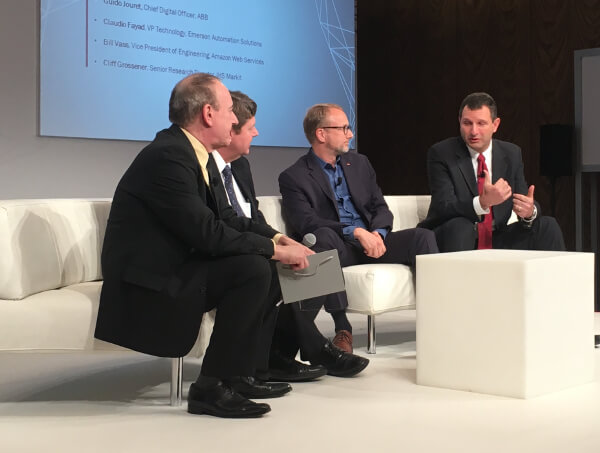Huge amounts of data combined with powerful analytics applications running in cloud environments are beginning to help solve some of the toughest reliability, efficiency and productivity challenges that manufacturers and producers face. Emerson’s systems and solutions business technology vice president, Claudio Fayad shared his insights in a panel, The Cloud, the Edge and future of connectivity, moderated by IHS Markit’s Cliff Grossener. Other panelists included leaders from Amazon Web Services and ABB. The focus of this session was:
The cloud holds the promise of a safe, highly scalable, and powerful means for managing huge amounts of data and computation. But the fundamental cloud assumption – consolidate compute and data in centralized data centers – is in direct contradiction to the typical energy data generation model of large, but distributed, data sets. How can new telecom network models, like 5G with compute moved to the edge, help the energy sector where locations are often off the grid? How will the cloud drive the shape of innovation across energy, with its structural impact of shifting traditional strengths from large incumbents with huge capital budgets to small early stage firms?
Cliff opened the session by describe the shift for enterprises to cloud based applications. He defined multi-cloud environments where a company may have applications hosted in different suppliers—Google, Amazon, Microsoft and others. Some applications such as controllers in control systems are mission critical and need to remain on premise and close to the process.
Claudio opened explaining the sheer number of sensors and final control elements with intelligence to self-diagnose, to diagnose the process and devices around them and provide information for control and for predictive maintenance. The edge computers historize and compress this information to pass along to the cloud.

At CERAWeek 2018, Emerson’s Claudio Fayad describes applications and use cases for local control, edge and cloud-based computing to improve project and operational performance.
In the cloud, applications can simulate the process and control system for training, testing and optimization on the offline system to improve the online system, and high-powered analytics to diagnose ways to improve safety, efficiency and reliability. Claudio emphasized that the system, the edge and the cloud all have a role to play in improving operational and business performance.
The edge devices can aggregate information from different environments—control systems, safety systems, asset management systems and others to develop consolidated data sets for analytics. With one-way communications technologies, such as data diodes, this data can be further consolidated in cloud hosted applications to be shared by experts for analysis and decision making no matter where they live across the globe.
For the energy industries, Claudio highlighted the opportunity to use a cloud-based architecture to integrate across the hydrocarbon supply chain—from exploration and production through to refining and petrochemical production to optimize and create value across this chain. Instead of the delays of finding, aggregating and analyzing silos of data, this data can be available to improve the speed of decision making and actions to meet demands.
One current very valuable case for cloud computing is executing capital projects. The design can be shared by project team members no matter where they are located. There is one source of truth to collaborate and advance the project. The engineering work can be tested and proven out before it is deployed on site.
A second example is a digital twin where the control system is virtualized and a model of the process characteristics is simulated and supplied with data from the live system. When further developing the project, the current state of the process can be used as a starting point for the project, instead of the old project documents that need to be first updated.
Visit Emerson.com more on applications for cloud applications with distributed control systems.




